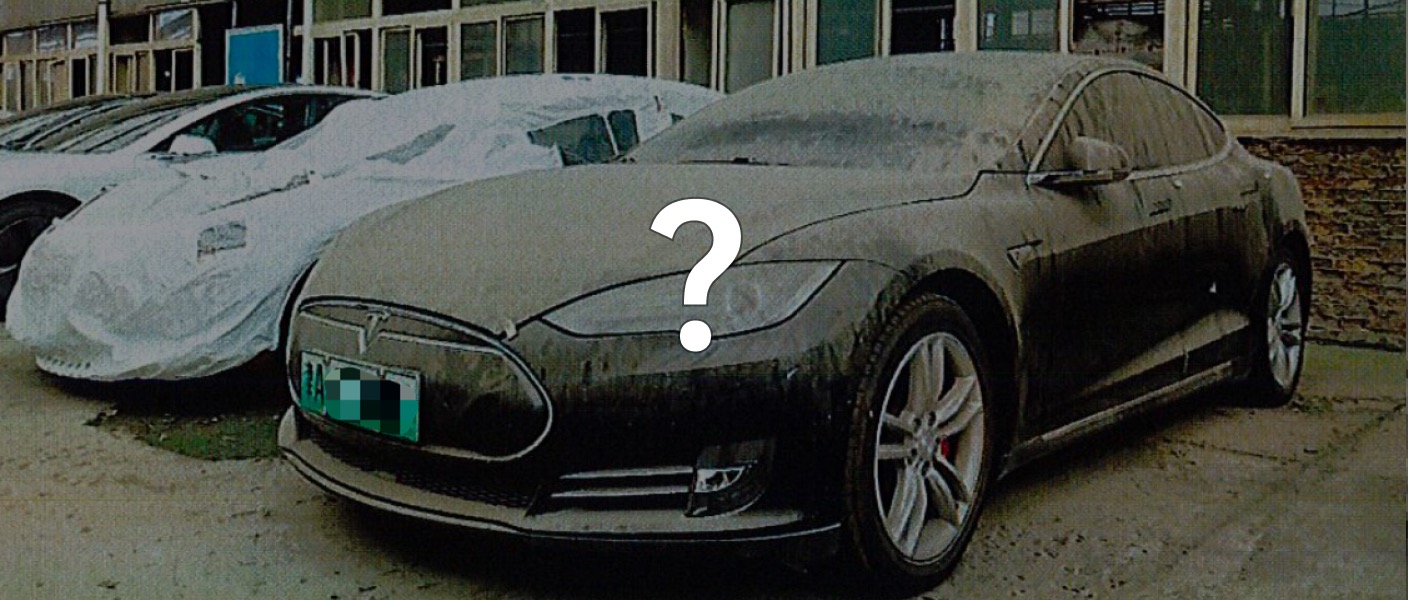On December 4th, 2020, after more than a year of rights protection, Han Chao received a civil verdict issued by the People’s Court of Daxing District, Beijing. In the first instance verdict, the court found that the defendant Tesla had committed fraud, and Tesla was ordered to refund Han Chao RMB 379,700 for the car purchase and compensate RMB 1,139,100 according to the Consumer Protection Law.
However, the matter did not end there. Tesla did not agree with the verdict of the first instance and subsequently appealed, and the case will be brought to the second instance.
Regarding this incident, we have heard many different voices from all walks of life. In order to further understand the details of the matter, we have recently interviewed Tesla’s legal department and car owner Han Chao, and the controversies in this case have gradually become clear in the process.
What happened, and what is the dispute?
Let’s first review the course of events, based mainly on the first-instance verdict issued by the court. If you already have sufficient knowledge of the event, you can skip the cause section.
Review of the Cause
On May 31st, 2019, Han Chao purchased an officially certified used Model S through the Tesla website and signed the “Used Car Order Agreement” on June 1st.
Before purchasing the car, Tesla promised that its used cars for sale undergo more than 200 inspections before the vehicle is transferred, have good condition without structural damage, are vehicles under five years old and with total mileage of no more than 80,000 kilometers, and only certified used vehicles that meet Tesla’s standards can be sold on the Tesla website.
From June 5th to August 24th, 2019, in the 80-day period, the Model S purchased by Han Chao frequently had problems and was repaired a total of 7 times.
On August 24th, 2019, while driving, the car suddenly broke down and both the accelerator and brake failed, almost causing a major traffic accident. Han Chao then sent the car to a Tesla designated repair center for repair.
On November 15th, 2019, after being appraised by Tianjin Wanfeng Motor Vehicle Appraisal and Assessment Co., Ltd., it was found that the vehicle involved had structural damage and was an accident vehicle. Han Chao believed that Tesla had fraudulently sold him an accident vehicle that did not meet its promises, and therefore filed this lawsuit.
Key Contradiction
The core issue of this case is the determination of “fraud”.
In short, the car owner Han Chao believes that Tesla sold him a Model S that did not conform to the official promises of Tesla’s car sales, concealed information about the cut and repaired fender, and the vehicle was an accident car. Tesla’s actions are considered fraudulent.
On the other hand, Tesla believes that the fender of the Model S sold to Han Chao was cut and repaired, but this is a common repair method for aluminum body scratches, and it did not affect the structure of the vehicle. The car is not a major accident car and meets the sales promise, and there was no deliberate concealment or fraud.Another key controversy in the fraud determination is whether there is structural damage to the Model S in question, and both parties still have different opinions on this issue.
This dispute did not yield a definitive conclusion in the first trial of the court, but the court still made a first-instance judgment.
First-instance judgment
The original text of the first-instance judgment of Daxing District People’s Court (the first-instance judgment result is no longer valid after Tesla appealed) is as follows:
Before and after the transaction, Tesla’s statements about the condition of the vehicles involved mainly revolved around the level of “no major accidents or burnt or water-damaged cars, and no structural damage“.
However, except for the objective judgment of whether it is a burnt or water-damaged car, there are no relevant objective standards for the definition of “major accidents” and “structural damage“.
As a professional automobile manufacturing and sales enterprise, Tesla should, in accordance with the principle of honesty and creditworthiness, make specific and detailed explanations of the condition of the transaction vehicle, especially the accident and maintenance history, within a reasonable range when selling its official certified used cars to consumers. Otherwise, when there is a difference in understanding of relevant terms between both parties and there is a lack of objective authoritative identification standards, a disadvantageous explanation should be given to Tesla.
In this case, Tesla’s evidence submitted is insufficient to prove its claim when there is a disagreement between both parties about whether the vehicle involved suffered structural damage due to an accident.
In addition, from the repair photos of the vehicle submitted by Tesla, it is evident that the repairs on the vehicle involve extensive cutting and welding, and this repair method and degree will inevitably have a significant impact on consumers’ willingness to buy, and Tesla’s mere statement to Han Chao that “the vehicle has no structural damage” does not reach the level of information disclosure that should be provided.
Regardless of positive actions or passive inactions, Tesla meets the objective elements of fraud. Regarding the issue of whether Tesla has fraudulent intent, based on the comprehensive facts of this case, Tesla is aware of or should be aware of the accidents and maintenance history of the vehicle involved and possesses the subjective conditions for fraud.
The three main points of the above judgment can be summarized as follows:
-
In the case of the dispute about whether the car is an “accident car”, Tesla did not give the owner a “detailed explanation” as much as possible;
-
Tesla’s explanation and evidence that the vehicle is not an accident car and has no structural damage is insufficient to prove its claim;
-
Tesla meets the subjective conditions for fraud: did not tell the car owner the true information, whether it was actively concealed or passively inactive, and meets the objective conditions: Tesla knows or more or less knows about the accident information.
At this point, you can roughly understand the content, controversies, and the court’s opinion of Tesla’s fraud in this rights protection case. However, currently, this ruling is no longer valid due to Tesla’s appeal. Based on this information, we conducted relevant interviews with both parties in the case.
Interview content许律师:首先,我们认为一审判决在认定欺诈方面存在不足。另外,就是关于车辆情况的详尽解释方面,我们的回应是在回购过程中按照二手车行业交易惯例,确保车辆没有受到结构性损伤、水烧、水泡等重大事故,并没有故意隐瞒车辆维修历史。所以我们认为在这方面,我们并没有做到应该尽可能详尽的解释。Lawyer Xu: Yes, this is a statement from the first-instance verdict. However, in actual practice of selling a second-hand car or in the industry practice of second-hand car transactions, it is impossible to provide a specific and detailed explanation of the accidents and repairs of a car, as envisioned in the ideal state of the verdict.
Why? In fact, not only Tesla, but also other second-hand car dealers can be understood by professionals in the industry. Some famous dealers in China are available to everyone. Now, the core promise in the second-hand car transaction is that there is no structural damage, no major accidents, and no fire or water damage.
For general repairs of vehicles, most dealers cannot provide a specific and detailed explanation to each inquiring customer, as the general repair history of a second-hand car involves dozens of items, which may involve various repair terms. If a consumer has to provide a specific and detailed explanation for each repair item when purchasing a second-hand car, the transaction cost of the car will be very high, which is impractical in reality.
This is also why the current practice in the entire second-hand car trade is not to be entangled with consumers about the general repair history of vehicles during sales, but to include it directly in the car price.
The most important thing is to promise to consumers that the car has no major accidents or structural damage, which is a common practice in the industry. Therefore, we also think that the so-called standard of the verdict is too idealistic. Our car is actually a normal car with general repair history. We do everything normally, including the pricing for repurchase and sale. There is no fraud involved.
Garage 42: You just mentioned that Tesla promises no structural damage. I saw in the court documents that both third-party appraisals did not support Tesla’s view. How do you see this?
Lawyer Xu: There was only one appraisal, not two. Han Chao asked Tianjin Wanfeng Motor Vehicle Appraisal and Evaluation Co., Ltd to issue a conclusion that the vehicle had structural damage, and I can explain this in detail.
Wanfeng Motor Vehicle Appraisal and Evaluation Co., Ltd is a senior second-hand car appraisal and evaluation company and not a judicial appraisal agency. They have a misunderstanding. They believe that what is written in their appraisal report is that because the rear fender of the car is connected to the C-pillar, cutting the fender is the same as cutting the C-pillar, which is entirely wrong.
During the trial, we also submitted to the court the cross-sectional structure chart of our vehicle provided by our Tesla body structural engineer, which clearly indicates the position of the C-pillar and the cutting position of the fender, which are completely different.In the field of the automobile industry, our country has its own national standard for assessing second-hand cars and a technical standard for repairing accident vehicles. These standards provide detailed regulations on what constitutes structural components of a vehicle, permissible methods for repairing the fender, such as the cutting and repair approach used in this case, and safety standards to which repaired fenders must adhere. We explained this to the court during the trial and demonstrated that the claim made by the so-called “Wanfeng Motor Vehicle Appraisal Company” regarding the structure of the vehicle was completely incorrect.
In fact, the first-instance ruling did not make a legal judgment on whether the vehicle was structurally damaged. Regarding this issue, the court documents from the first instance state that, in the absence of agreement between the parties, Tesla’s submitted documents were insufficient to prove that “the vehicle was free from structural damage”.
In my personal opinion, the first-instance ruling in this regard was not entirely accurate. I believe that the evidence we submitted fully demonstrated that our argument was that the car absolutely had no major accidents or structural damage. Furthermore, both the automotive repair industry and vehicle manufacturing companies have clear national standards and industry practices to determine what types of accidents and structural damage qualify as major.
During the trial, another determination made by the first-instance court was that Tesla failed to inform the owner of the vehicle that it had undergone a cutting-and-mending repair process when Tesla was already aware of it. The court believed that Tesla should have informed the owner, and that Tesla had failed to do so.
In fact, as I mentioned earlier, we believe that fender repairs are common repair operations. Based on the industry norms of second-hand car transactions, there is no requirement to inform the buyer. Therefore, it is difficult to conclude that Tesla deliberately concealed the repair from the buyer.
Since the previous owner repaired the fender at a third-party repair center, the repair company will have a detailed maintenance record. The record will be uploaded to the insurance company’s claim record if the previous owner filed an insurance claim. However, our Tesla aftersales system only shows that there was a record of the order of the fender, and we identified the car as having a fender repair when we repurchased and appraised the used vehicle.
In fact, automobiles are very complex industrial products that require expertise in many technical aspects. It’s hard to say when to inform consumers because there is no clear standard. The practice is based on a mature market that can gradually establish conventions. There are many things we would like to tell consumers, but they may not be able to fully understand them.Translate the Chinese Markdown text below into English Markdown text, in a professional manner, preserving the HTML tags inside the Markdown, outputting only the result.
As stated in the first-instance judgment, the so-called issue affects the consumers’ willingness to make purchases. However, buying willingness is a very personalized and subjective thing. Some consumers will not buy a car just because the paint on it does not look very shiny. Do you think this belongs to the defect that affects purchasing willingness?
On the contrary, we believe that the judgment on the defects or issues that a car has to reach and to what extent in the judicial ruling should be based on some common and more objective standards of the entire market. We cannot be too subjective and say, “I think consumers may not want to buy it when they see it, so I think your car has affected his purchase willingness, which is inappropriate.”
I believe that in many other judicial rulings, there is a more fair determination for situations like this case.
Tesla’s Point of View Overview
To briefly summarize Tesla’s core views:
-
The basis for the first-instance judgment of Tesla’s fraud is not sufficient, and the standard for fraud in similar domestic disputes is inconsistent;
-
The maintenance records of the vehicle can be queried, and Tesla did not deliberately conceal them;
-
There is no clear standard for the information that needs to be disclosed to consumers in the second-hand car transaction, mainly based on industry conventions, so the court needs to look at this issue more objectively based on the current market situation;
-
The court’s standard for information communication in second-hand car transactions is overly idealistic. There are many information items for the vehicle, and the actual cost is high, which is difficult to achieve;
-
The repairing of the fender (cutting) is general maintenance and does not cause structural damage, complying with the core promise of selling a car without burning, blistering, or structural damage;
-
Because Tesla believes that the repair of fenders (cutting) is general maintenance, it did not specifically explain it to Han Chao when he purchased the car;
-
Purchase willingness is subjective, so there is no standard for its impact, and the judgment made in the first instance is not appropriate.
Han Chao Interview
Car owner Han Chao expressed his opinion on the relevant controversies in our interview.
Garage 42: In the first instance, Tesla claimed that the Model S they sold had only undergone routine fender cutting and repair without damaging the vehicle’s structural components, which complies with the promise they made when you purchased the car, that is, there is no blistering, burning or structural damage, so there is no fraud. How do you view this matter?
Han Chao: First of all, I refute this so-called cutting part. That is to say, our rear fender can only be repaired through cutting. I sent you a video, the recording of which shows that they did cut it, and there is a conversation from the WeChat of the Tesla authorized paint and sheet metal center, China Leirui. They also emphasized in the conversation that the fender belongs to the structural component, which is the first point.
The second point is that if it is a true minor scratch or something, it can be repaired through sheet metal. This is one of the evidence because this evidence was also presented in the court of the first instance.##### Garage 42: Equals is the third-party authorized version center by Tesla, which means it belongs to a structural component, right?
Han Chao: Yes. Then the second one, I’ll send you the information I just posted on Weibo. This is our national standard. This standard explains in relative detail about the body structure components and the body structure itself. I also made a relevant discussion on Weibo, which emphasizes that the body structure component refers to the parts that make up the body, support the covering parts, and ensure the strength and rigidity of the body.
Then let me explain it briefly. The definition of this structural component is particularly clear, which means it forms the body structure. The definition of the body structure is a structural part that cannot be disassembled after the structural component and covering component are welded or riveted together, which is particularly clear.
Because the cut parts are originally welded to the C-pillar and some other structural components in the factory, they cannot be disassembled except through cutting and welding. Therefore, it meets the basic concept of the body structure. If it meets the body structure, it is equivalent to belonging to the body structure component.
Therefore, Tesla’s legal department has been emphasizing whether the judgment of the case is based on their Tesla user manual or the national standard.
Garage 42: Regarding the issue of vehicle maintenance and cutting, there is currently a difference of opinion between the parties. Tesla believes that two appraisals by third-party institutions, both of which were agreed by both parties in the court, do not provide sufficient evidence to determine that the vehicle has structural damage. Currently, the court has no conclusive decision on this issue. What is your opinion?
Han Chao: Because all their rhetoric now is in favor of their own interests, the three parties used a judicial appraisal institution. This institution is the only judicially designated automobile-related appraisal institution in the Beijing judicial financial deposit library. It has judicial filing, and all the bases they used are based on our national standards.
As for their so-called cross-sectional diagram, they can provide it randomly. I can send you a structural diagram of an aluminum body that they issued to their authorized spray center. You can see the English on it, and you can understand that this thing is what Tesla provided.
The structural schematic diagram that they authorized to the spray center obviously includes the cut parts, which can be seen from the picture now.##### Garage 42: Regarding the fraud issue, according to the court’s verdict, Tesla did not provide a detailed explanation to you under the premise of knowing about the fact. They believed that cutting and repairing the damaged fender was a commonly accepted repair method in the industry, and would not cause structural damage to the car’s body. Therefore, when buying back used cars from customers, they did not lower the price for this type of repair. Tesla also believed that this was something that the industry should know, so they did not provide a very detailed explanation to the car owner, thinking that it was unnecessary.
Here I would like to ask you, assuming that this repair does not actually cause structural damage to the vehicle, would the information about the cutting and repairing of the fender still affect your willingness to purchase the car?
Han Chao: Let’s give a simple example. At the time, they were selling two identical cars, one with slightly higher mileage and one with slightly lower mileage. I had to choose, and they also made recommendations. Finally, I chose this car.
Both cars were exactly the same in terms of configuration, performance, architecture, and year. So for normal consumers, why would I choose a car that has been cut? Even if they have the same configuration and price, it doesn’t make sense.
Let’s think about it another way. If we go to a used car market to choose a car, would you choose a car that has been cut first? Even if it does not involve structural damage, it will still result in huge depreciation.
Garage 42: I see, so you believe that this type of information is necessary to be explained to you before purchasing the car, even if it does not involve structural damage.
Han Chao: And before the sale, I specifically asked them for the relevant inspection of the car. I asked them for everything, but I couldn’t find any information through the VIN in any paid software.
Garage 42: So, this repair record was not found in the information provided by Tesla and the information you paid to search for, right?
Han Chao: Correct, you cannot find any relevant records through the VIN.
Garage 42: Tesla stated that they were also not fully informed about the previous owner’s repair of the fender, and they only have a purchase record of the fender.
Han Chao: I just sent you another picture. This is an official information from their previous official website. They made a detailed description of their authorized version. You can take a look at the content. They cannot claim that they were not informed.
Summary of Han Chao’s views
Here is a summary of the views of car owner Han Chao:
-
The personnel of the Tesla authorized sheet metal and painting center, CIIC Leirui, stated in their WeChat conversation that the fender is a structural component, and also indicated that small scratches did not require cutting for repair.
-
The fender replacement for this type of Model S can only be done by cutting and welding, which complies with the definition of “body structure” in the national standard for vehicles. Therefore, it is considered a structural component, which is included in the body structure diagram of Tesla’s sheet metal and painting center.
-
Even if the fender does not have any structural damage, repairing it would still have a significant impact on resale value, which would concern ordinary consumers and objectively affect their willingness to buy the car.
-
Tesla did not inform customers of the repair history of the fender, making it impossible to obtain information through the vehicle identification number (VIN) or any third-party paid software.
The above is a summary of the statements made by both parties during our interviews. It is clear that both sides have their own views and reasons regarding the disputed points. Both sides also mentioned national standards, and the corresponding documents are discussed below.
Discussions under the standard, considerations beyond the standard
After the interviews, Tesla provided the following image of a vehicle before it was repaired following an accident. As shown below, the fender on the left rear of the vehicle was scratched. Tesla’s lawyer Xu said that in this accident, the aluminum fender of the vehicle was torn to a certain extent, so it had to be cut for repair.


Let us examine the national standard that is relevant to this repair.
Standard 1: “Terminology for Vehicle Bodies” GB/T 4780 – 2000
This national standard has a clear definition of the terminologies used for the body parts of a vehicle.

The term “white body” on this page is defined as “an assembly composed of the body structure, opening parts and other removable structural parts”. The term “body structure” is defined as “an assembly that consists of structural components and covering components that are welded or riveted together and cannot be disconnected”.“`
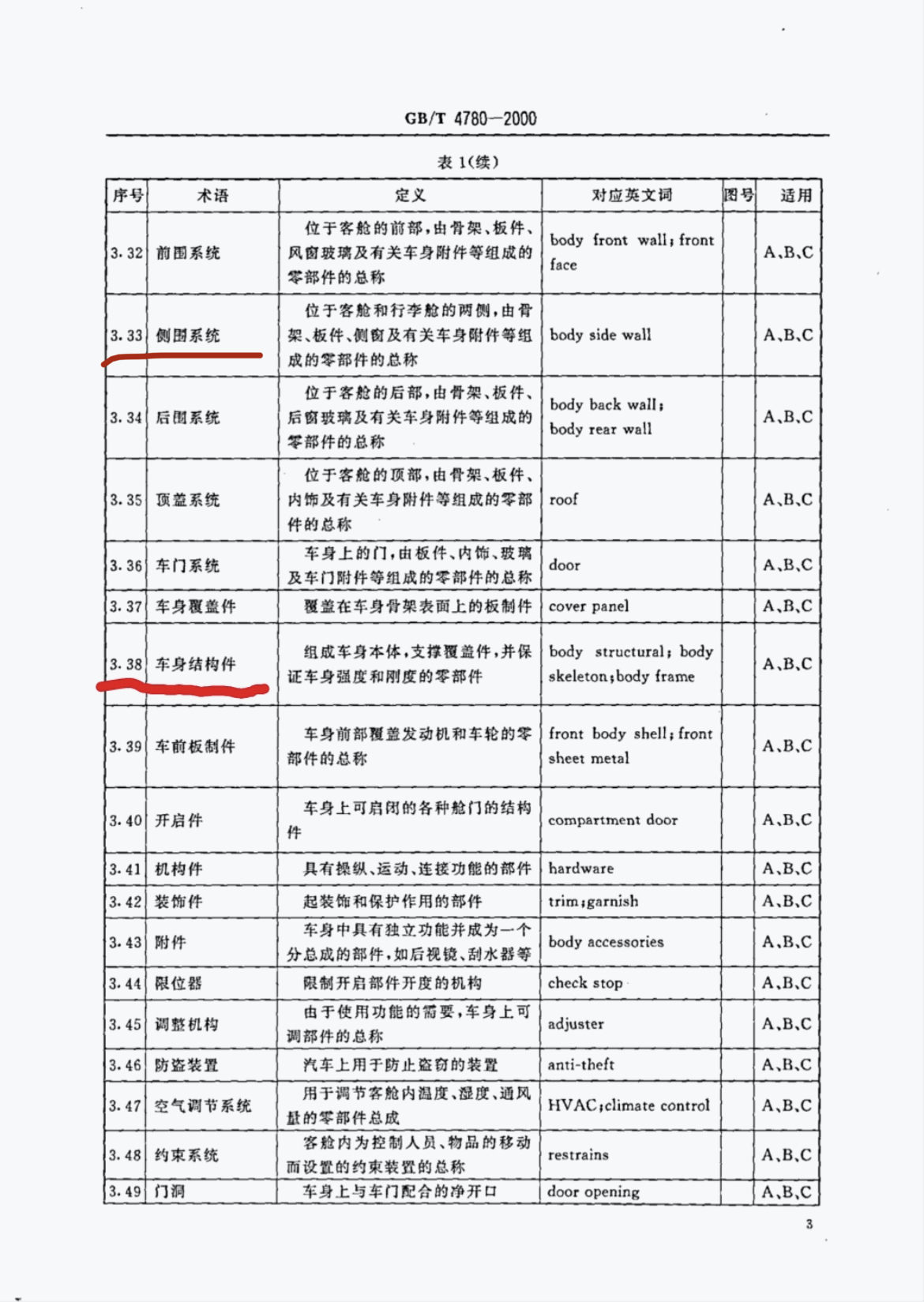
The definition of “body structural components” on this page is: A component that makes up the body, supports covering parts, and ensures the strength and stiffness of the body. Above it is also the definition of “side trim system”: a general term for components located on both sides of the cabin and luggage compartment, composed of skeletal, sheet metal, side windows, and related body accessories.
The definition of these terms is clear, but the attribute definition of the Model S rear fender seems to be difficult to determine.
It is a “side trim system” component, a “white body” component, and also a component of the “body”, but it may not necessarily be a “body structural component”.
Because according to the standard, “body structural components” must meet three conditions: they are components that make up the body, support covering parts, and ensure the strength and stiffness of the body. The side trim fender must be a component that makes up the body, but the latter two cannot be determined based on current information.
Moreover, the seemingly clear definition still has uncertain aspects. What does it mean to “ensure” the strength and stiffness of the body?
But what we are talking about here is the fender, and the actual situation seems to be more than just the fender.
Standard 2: “Technical Specification for Second-Hand Car Appraisal and Evaluation” GB/T 30323-2013
Pages 4 and 5 of this document clearly list the criteria for identifying “accident vehicles”.
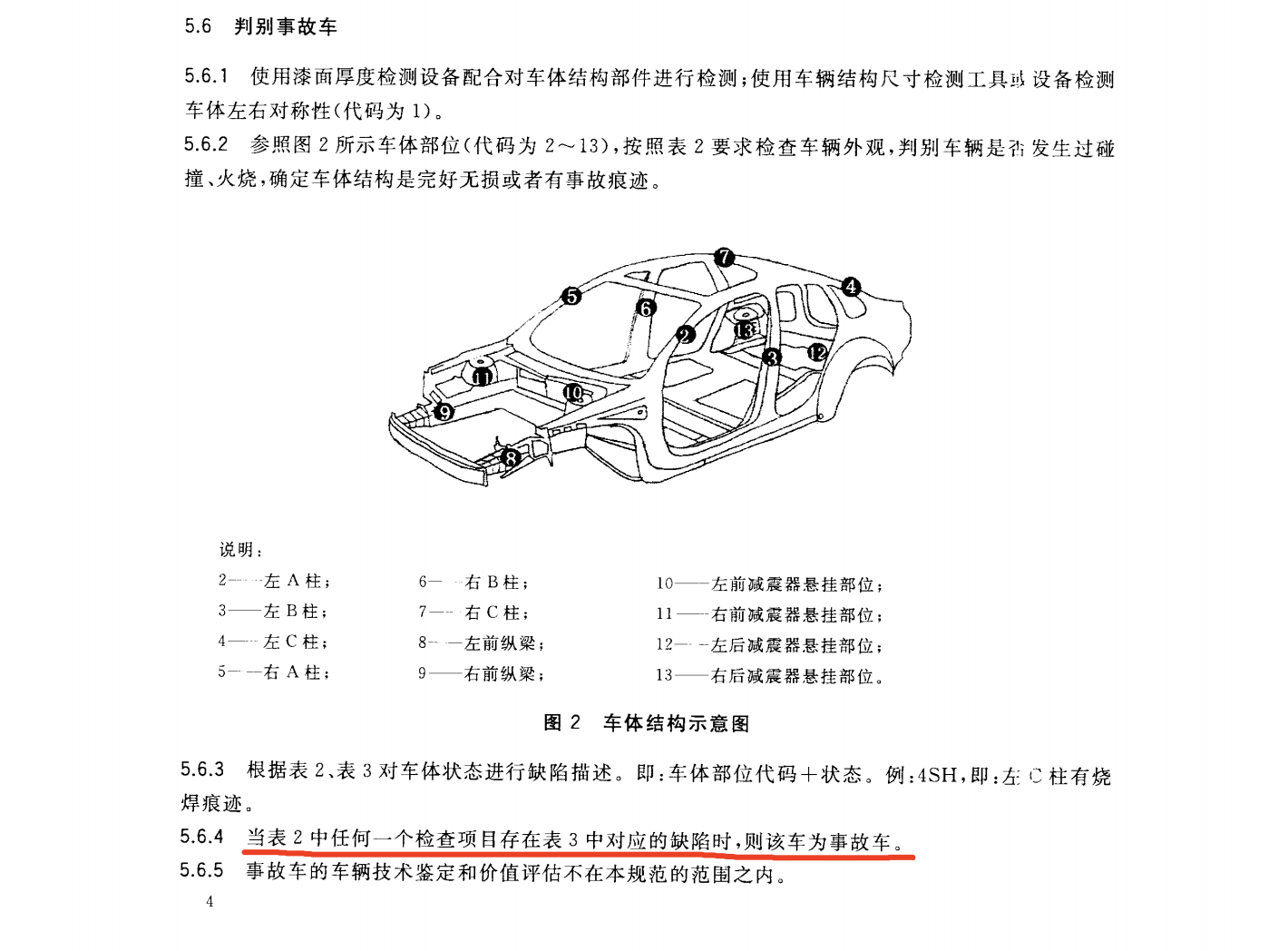
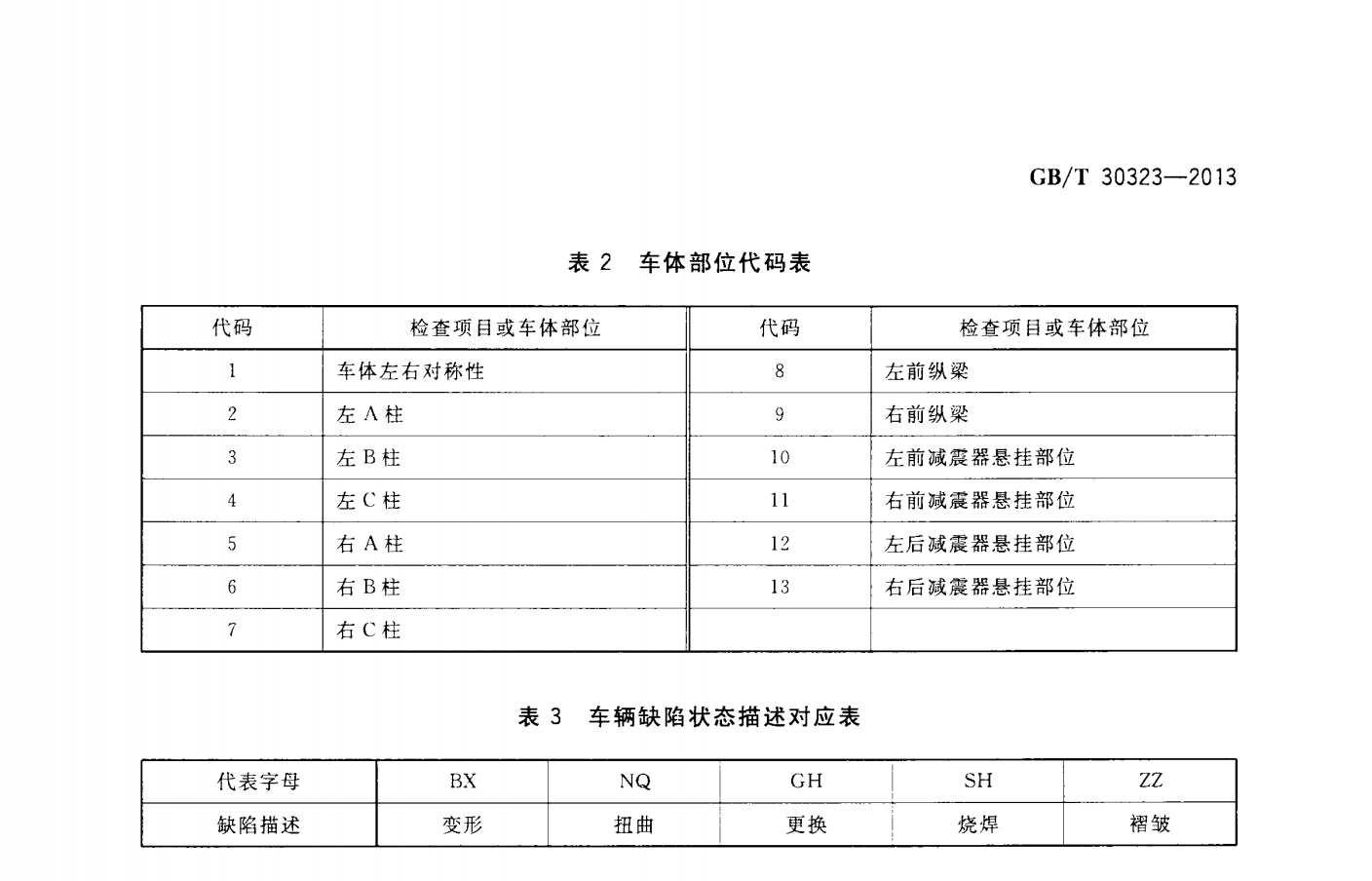
Combining the currently known information, the C-pillar of the involved vehicle did not have the above defects during the crash, or in other words, did not have these defects before the repair.
However, the body of the Model S is quite special. The rear fender and C-pillar are designed as one unit, and replacing the rear fender requires cutting and repairing.
The following picture is a picture of the Model S body exhibited by Tesla’s auto body and paint center provided by Han Chao.
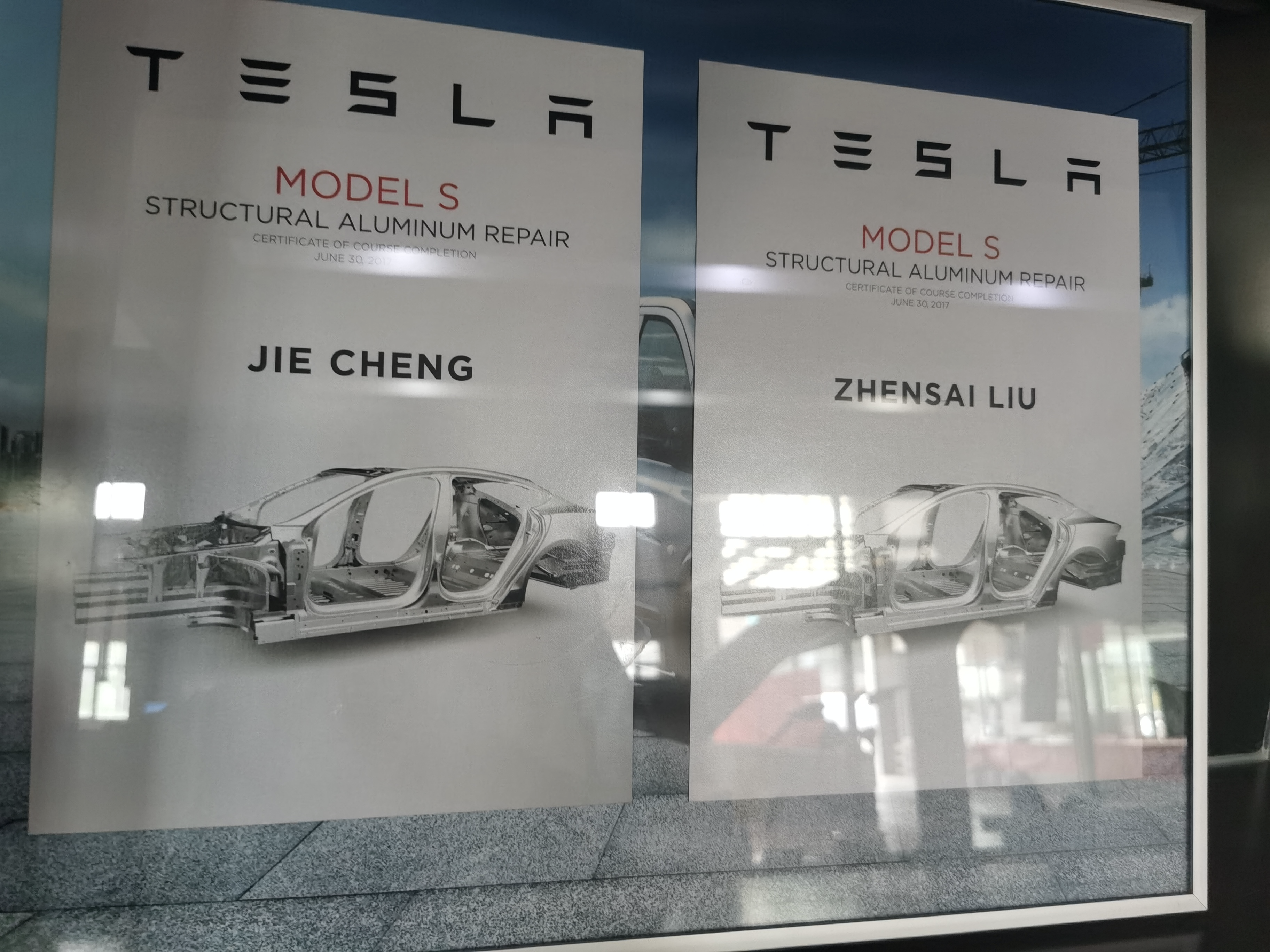
This is a picture of the repaired car submitted to the court by Tesla, with the cut and repaired parts marked.
“`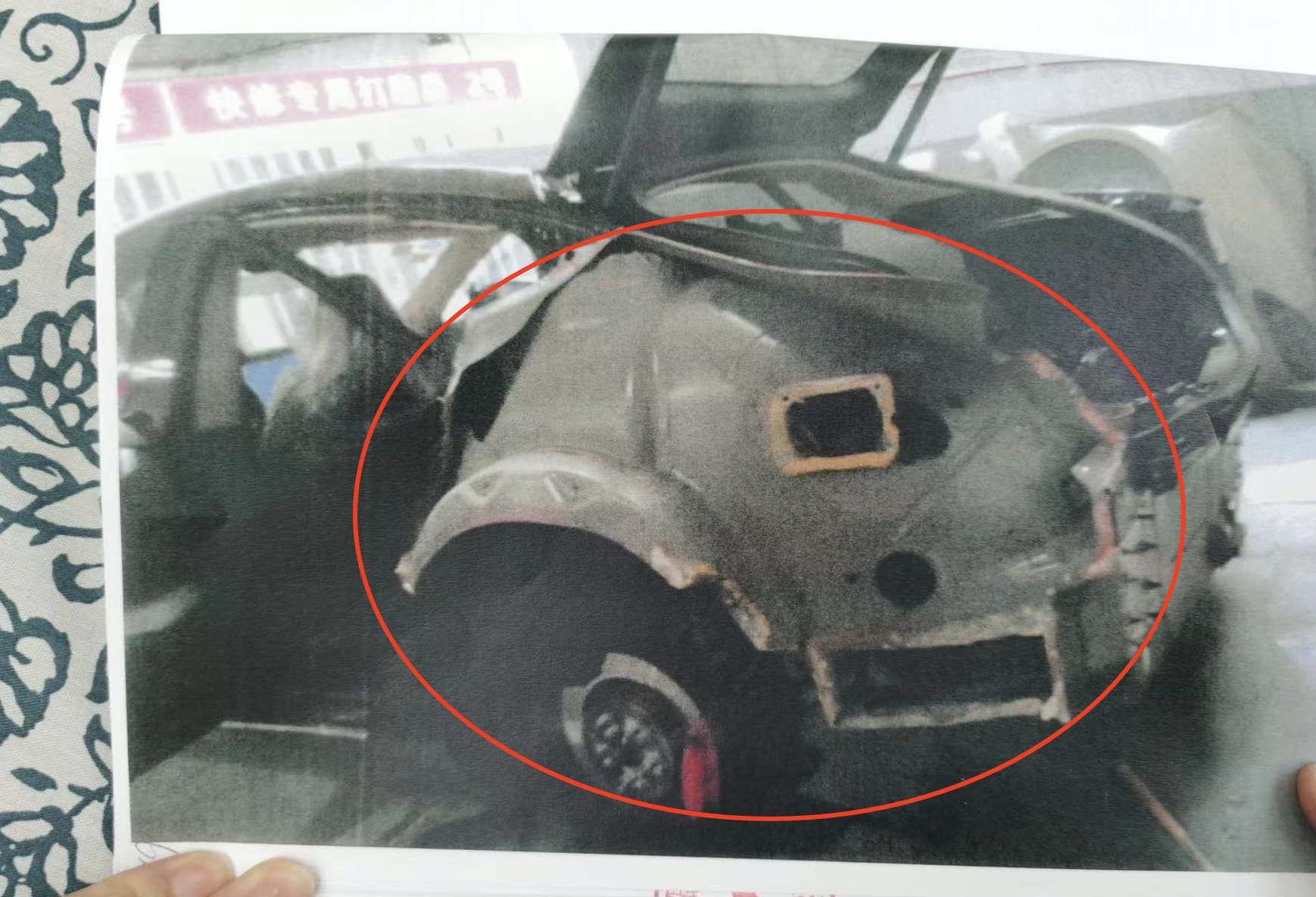
In the judicial appraisal report file conducted by Beijing Jing Shi Motor Vehicle Appraisal and Evaluation Institution for the second time, traces of vehicle repairs can also be seen.
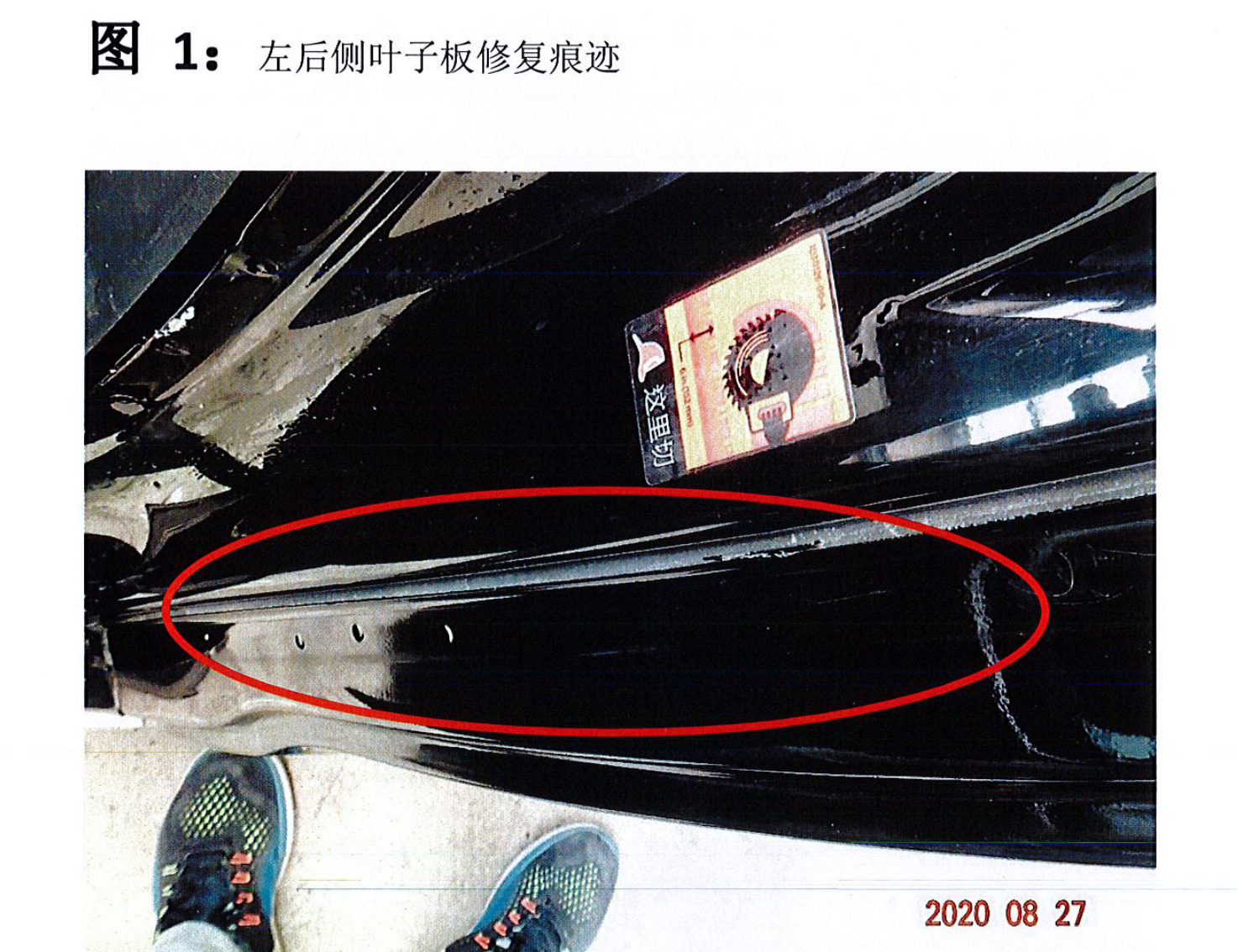
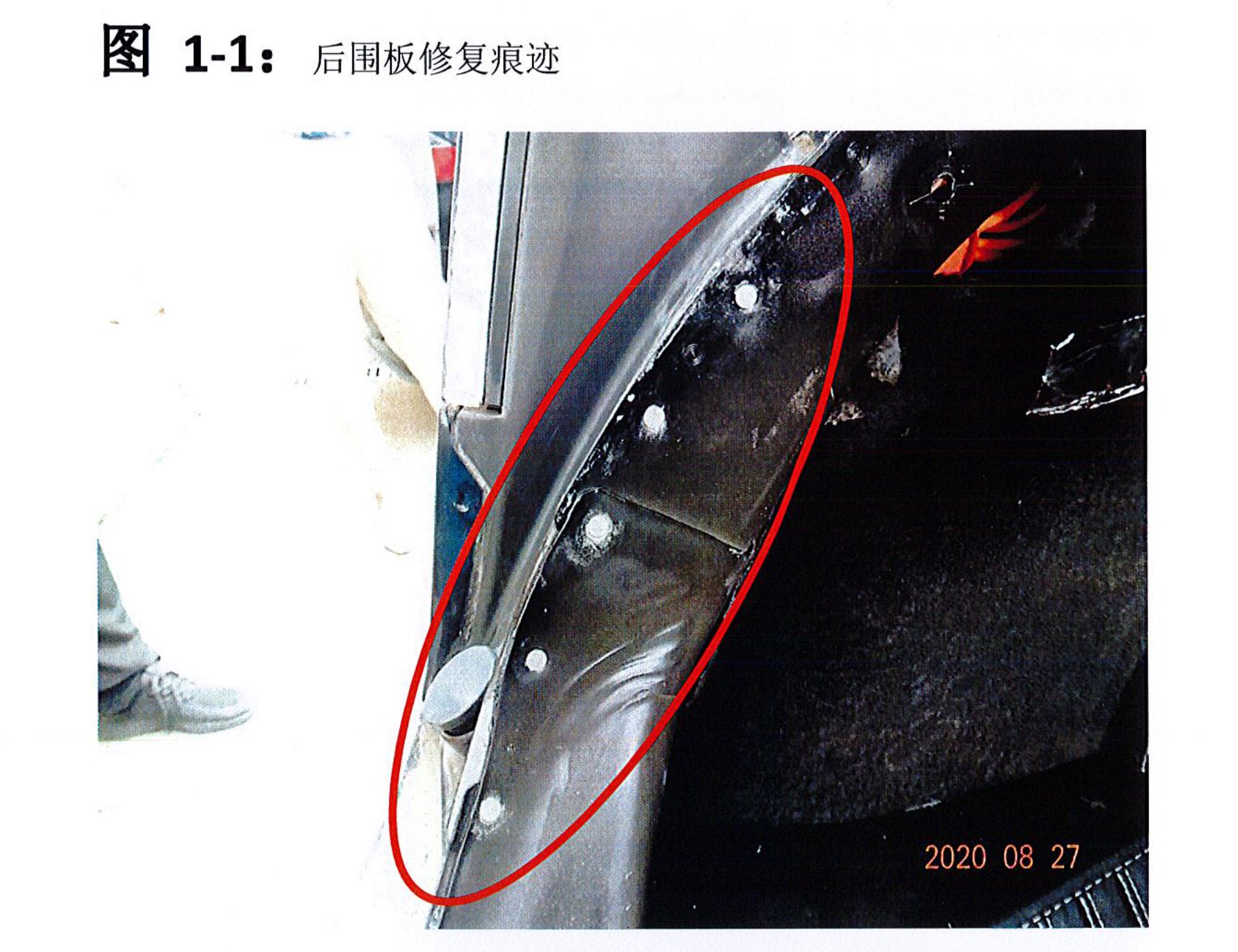
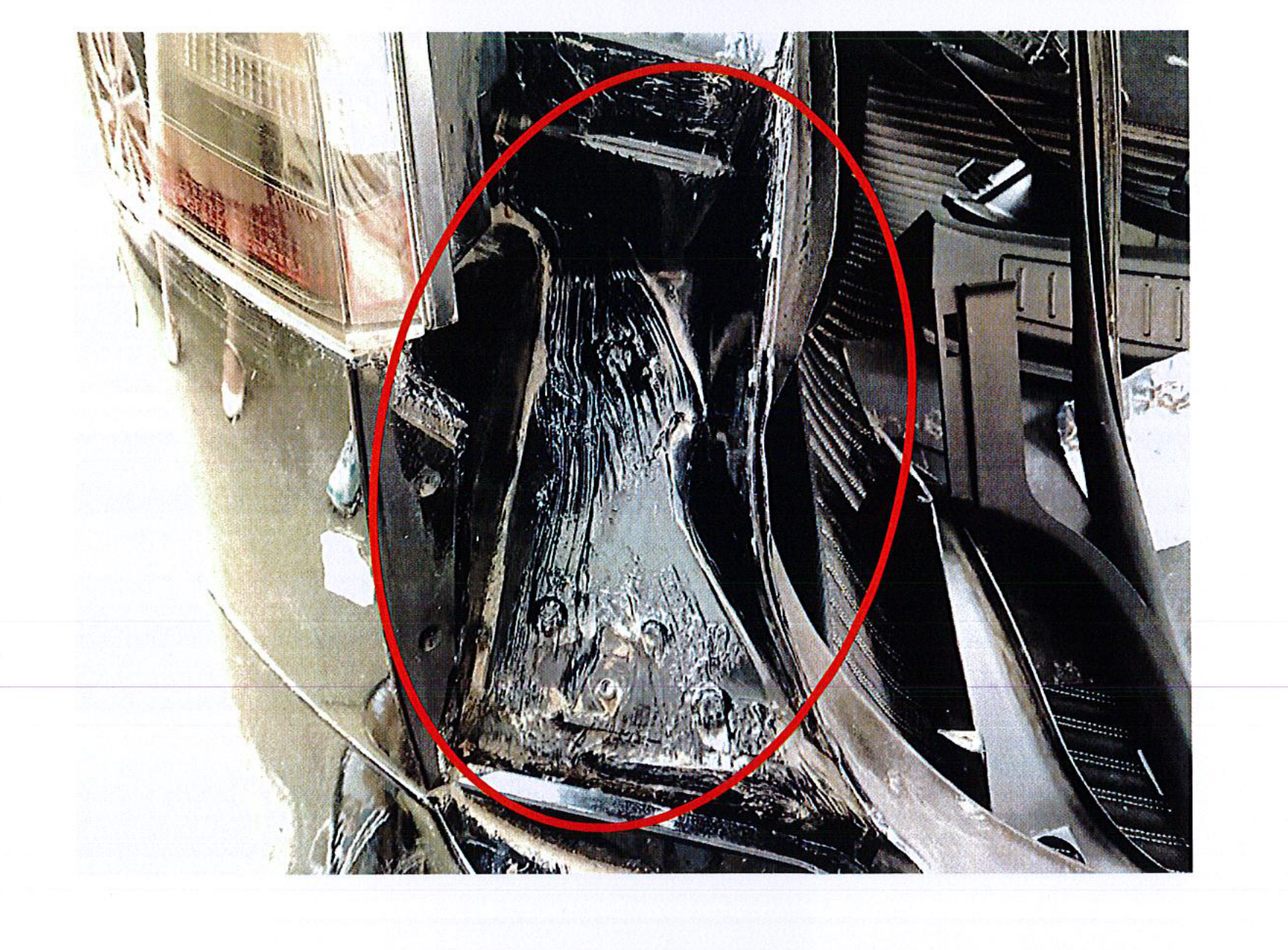
After seeing these pictures, we can feel that the cutting part is indeed not small. The judicial appraisal opinion of the involved vehicle was conducted by Beijing Jing Shi Motor Vehicle Appraisal and Evaluation Institution, which was agreed upon by both parties for the second time.
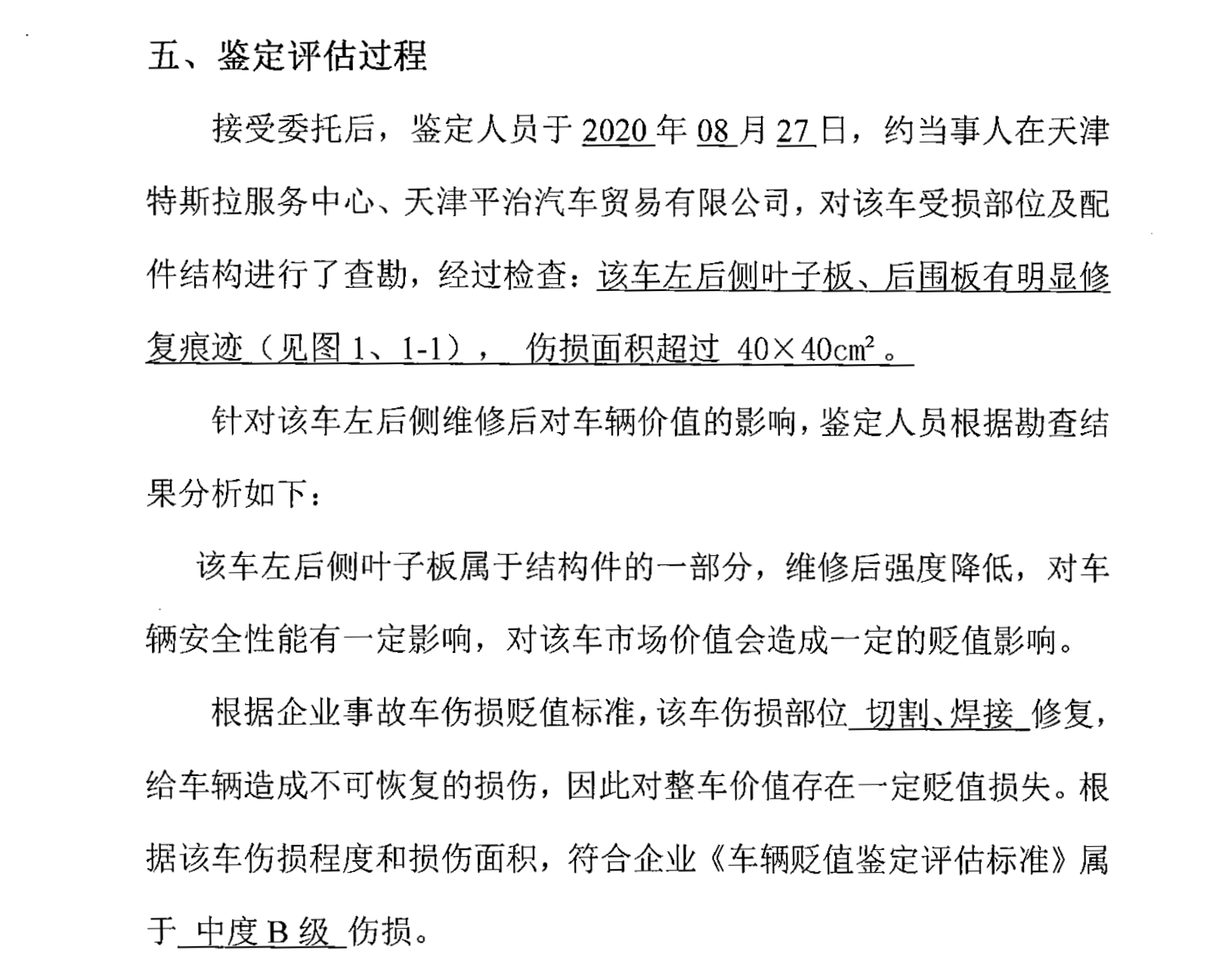
However, the court has not made conclusive findings on whether the C-pillar of the involved Model S was affected in this repair.
However, using “general repairs” to describe the degree of cutting repairs for the involved Model S, is indeed difficult for ordinary consumers to accept.
Issues and impacts exposed by the rights protection event
As a representative of the industry’s direct sales model, Tesla has attracted many consumers with its transparency of information. However, Tesla’s practices in this year’s HW chip event, Model S/X suspension mandatory recall and other issues have also disappointed and puzzled consumers.
It has been 17 months since Han Chaogou bought the car, and as an individual consumer, he faces great resistance in his rights protection. So far, he has spent high costs of time, money, and energy. On the other hand, Tesla has also been negatively affected by this rights protection event.
However, this event also revealed a larger problem- “there are no specific standards“. What exactly is “structural damage”? How are “major accidents” classified? What is the “as detailed as possible” information that second-hand car dealers need to inform before selling their cars?
When disputes arise, either there are no specific standards to refer to, or the existing standards are not clear enough. This is also the reason why the two sides in this case each believed that their own views were correct, and reflected the disorder in China’s second-hand car market.I am reminded of a statement made by lawyer Xu in an interview:
“When Tesla buys back second-hand cars, we won’t use (fender repair) as a bargaining point. It is not the right thing to do and the burden on everyone is smaller.”
However, during the interview, all five used car industry professionals I consulted with stated that “cutting and repairing fenders is something that must be heavily discounted at the time of purchase, but when selling a car to the next buyer, they will tell them that there is no impact, and this has long been an industry convention.”
We also consulted with many professionals who have experience repairing aluminum car bodies and their views on repairing damaged fenders are very consistent: “If the damage is minor, it can be repaired with sheet metal, but if it is major, cutting is necessary.”
However, when faced with the question of “will cutting for repair cause structural damage to the car?”, two of these professionals said yes and three said no. The difference still lies in the definition of “structural damage”.
In addition, many Tesla owners around me have experienced side-collision accidents, and “to cut or not to cut” can be said to be a very common question that owners encounter during repairs. Everyone’s concern is simple – they do not want their beloved car to be repaired into a major accident flood.
Lawyer Xu also stated that after the rights protection incident, Tesla has now added the history of cutting and repairing fenders to the items that need to be notified to consumers in the sales of second-hand cars. This change has increased communication costs. Under these circumstances, Xu said that Tesla no longer purchases second-hand Tesla cars that have a history of cutting and repairing fenders.
From the perspective of consumers, Han Chao, a car owner, bought a car that had undergone extensive cutting and repair without knowing it, and this repair record could not be found through the vehicle identification number (VIN). I believe that in the eyes of most consumers, this is already an unacceptable situation. After buying the car, a series of malfunctions occurred in the car, and on August 24, 2019, the car broke down while driving, with the accelerator and brake failing completely, almost causing a major accident. These are things that no one wants to experience.
This incident happened 17 months ago, but Han Chao’s difficult road to rights protection has not ended. The court’s second trial has not yet begun, and the negative impact of this incident on Tesla is foreseeable and will continue for a certain period of time. We hope that the court can make a fair and just judgment for both parties, and we also hope that the impact of this incident can promote the formulation of relevant industry standards and the transparency of information in the used car market.
Otherwise, relying solely on “conventions,” there will still be another Han Chao after Han Chao.
This article is a translation by ChatGPT of a Chinese report from 42HOW. If you have any questions about it, please email bd@42how.com.
